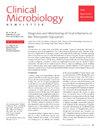噬菌体治疗无反应性感染:临床微生物实验室工作人员的入门读物
Q3 Medicine
引用次数: 0
摘要
随着抗菌素耐药性的增加以及随后对传统抗生素替代品的需求,噬菌体疗法(PT)重新引起了人们的兴趣。就像抗生素一样,噬菌体或简称噬菌体,在根除细菌感染方面显示出了希望;然而,它们的根本区别需要特定的实验室协议和实践。作为细菌特异性病毒,它们必须被检测、复制和纯化,以确保安全性和有效性。噬菌体的窄谱活性提供了一种有针对性的感染方法,但也需要广泛的文库和药敏试验来匹配噬菌体和细菌。这种检测没有标准化,使研究和临床工作都变得复杂。这篇综述随后提供了临床微生物实验室PT的背景,并概述了PT的具体方案和实践,如经典的药敏试验方法和最新的方法。也涵盖了该领域的挑战和未来方向,以及临床和研究实验室人员的资源。本文章由计算机程序翻译,如有差异,请以英文原文为准。
Phage therapy to treat unresponsive infections: A primer for the clinical microbiology laboratory staff
With the increase in antimicrobial resistance and subsequent need for alternatives to traditional antibiotics, phage therapy (PT) has gained a renewed interest. Much like antibiotics, bacteriophages or simply phages, have shown promise in eradicating bacterial infections; however, their fundamental differences require specific laboratory protocols and practices. As bacterial-specific viruses, they must be detected, replicated, and purified for safety and efficacy. The narrow spectrum of activity of phages provides a targeted approach to infection but also necessitates expansive libraries and susceptibility testing to match phages to bacteria. Such testing is not standardized, complicating both research and clinical efforts. This review then provides a background on PT in the clinical microbiology laboratory and an overview of such protocols and practices specific to PT, such as classic susceptibility testing methods and updated approaches. Also covered are the challenges and future directions for the field, as well as resources for clinical and research laboratory personnel.
求助全文
通过发布文献求助,成功后即可免费获取论文全文。
去求助
来源期刊

Clinical Microbiology Newsletter
Medicine-Infectious Diseases
CiteScore
2.20
自引率
0.00%
发文量
35
审稿时长
53 days
期刊介绍:
Highly respected for its ability to keep pace with advances in this fast moving field, Clinical Microbiology Newsletter has quickly become a “benchmark” for anyone in the lab. Twice a month the newsletter reports on changes that affect your work, ranging from articles on new diagnostic techniques, to surveys of how readers handle blood cultures, to editorials questioning common procedures and suggesting new ones.
 求助内容:
求助内容: 应助结果提醒方式:
应助结果提醒方式:


